Are you tired of the same old guitar licks, tricks and scale sequences that sound great when played fast, but sometimes don't really fit well into all slower song? Do you envy all those great guitarists who achieve more by playing a single note than another guitarist achieved by playing 100? Very often these guys are referred to as soulful players.
Is it fair that they take all the glory whilst you have invested so much time to be able to play at a technical level that they wouldn't be able to? Of course it's not fair! But you can simply apply a few different aspects to your playing and not only be a competent technical player but also someone who plays with feeling!
I am going to give you some simple but very powerful strategies on how to achieve more by playing less. It doesn't mean however that you are going to have to work less to get there. It will involve investing some of your time into a more intellectual process but I promise that it's worth it! The good news is that you can do it away from your guitar during your lunch break or while commuting to work, so you don't actually have to have a guitar with you to make the most of this lesson.
First of all we are going to analyse the commonly overlooked soloing strategy of chord tone soloing. This strategy is just as applicable to both beginner guitarists and advanced players. Regardless if you are a blues, country, jazz or metal guitarist this lesson is for you.
Chord tone soloing is based around the chords from the progression of the song or piece we are soloing over. It is imperative to know what these chords are or at least to be able to identify them whilst playing over them. This can take some time to develop with ear training sessions, but again the plus side to this is that this can happen again away from your guitar.
Chord tone soloing is just one strategy to help you create and play great solos, so it is great to integrate it with other strategies to achieve even greater results. For this reason we will be adding some extra notes from the scale we use to create more tension in our melodies. Let's get started!
Step one: Let's pick a key - I chose the guitarist friendly key of C Major/A minor (No sharps and flats) for this example.
The chords are: C, Dm, Em, F, G, Am, Bdim, C
Roman numerals: I, ii, iii, IV, V, vi, viidim, I
Step two: Creating a chord progression. Generally I prefer using chords that have a lot of common notes. For example Am C Dm G are all quite similar with their chord tones.
Now it's time to extract the notes (chord tones) from each chord:
Am ( A C E)
C (C EG)
Dm (D F A)
G ( G B D)
In example one you will be playing only one note over each chord of the progression. This will be the root note of each chord. At this point it's not what phrasing strategy you are going to use but what notes you are going to play.
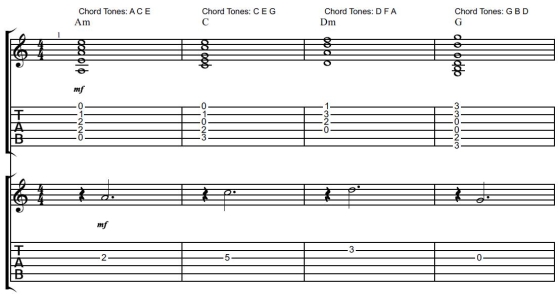
In example two we are going to play only the third note of the chord this will assure a very emotional feeling to the melody.
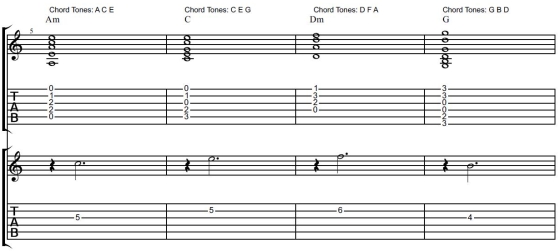
In example three we will play only the perfect fifth of each chord:
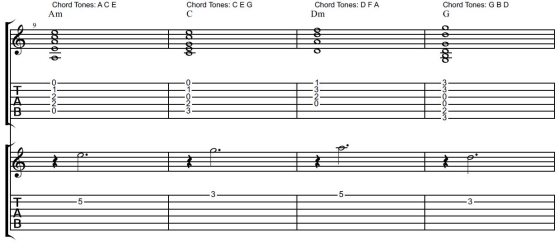
Example four is my attempt to play two chord tones over each chord to make the solo more interesting. Please note that in all of these examples I let the chord ring out first before playing any notes so these very basic solo ideas are a direct response to the chord of the rhythm guitar. This example will sound great if you use your whammy bar. You can even let both notes ringing together.
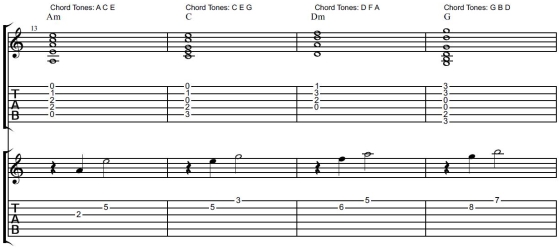
Example five is another possibility of the application of different notes that change the melody drastically.
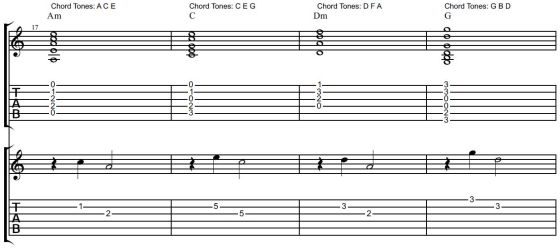
Example six will be another option. It will also serve as the melody structure for the next example.
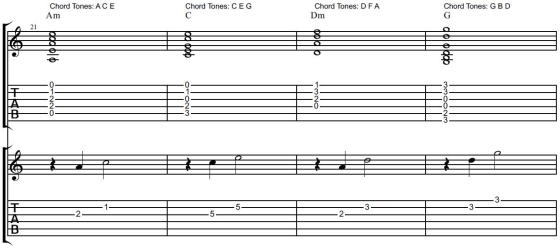
In this final example (example seven), I have used the same chord tones as above but this time I have included some extra notes, which we refer to as passing tones. These notes are part of the key and they help to create or maintain some tension to the music and add some nice colours to the main structure and sound of the melody.
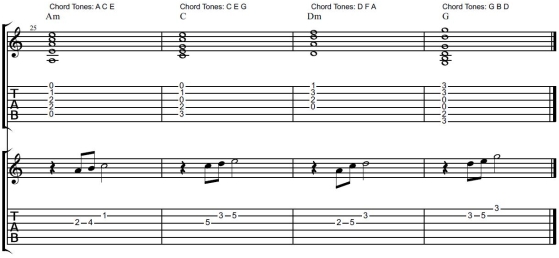
I decided to keep this lesson very simple as the main objective should be to figure out the notes of any chord that you play. Practicing these concepts will help you to build some unique phrases and in many cases inspire you to create something quite amazing. Practicing the guitar is occasionally more intellectual than physical so don't overlook this area of your playing as it often yields the best results.
If you happen to be a more advanced player why not use different phrasing concepts such as hammer-ons, pull-offs, vibrato bends etc? Try to play these ideas in different positions on guitar neck and get creative! You can also fit in more notes in between these chord tones to create some even more interesting phrases.
Make sure you watch this chord tone soloing video lesson to see how I phrase these examples. I have also included a special backing track for you that can be downloaded from my Wimbledon School of Guitar Website so that you can really get the most out of this lesson. Thanks for reading and happy playing!
Greg X is a professional guitarist and guitar instructor based in London, UK, He specialises in '80s rock and metal as well as neoclassical metal.
He is currently working on his '80s rock album featuring many accomplished musicians from USA and Europe. Greg X studied music at Goldsmiths College in London, UK.
He is being mentored by the world's top guitarist and music business coach Tom Hess. He has taught over a thousand of students. He is also a founder of Wimbledon School of Guitar in London, UK.